#the legend of heroes
The launch of Trails of Cold Steel on PC is here, which means it’s high time for the third and final iteration of this 3-part series of articles. The first part dealt with lifting the performance of the game to a level that I consider acceptable – great, even. The second one explained all the graphical options beyond the console version which were implemented in this port.
In this post I’ll introduce two final, previously unrevealed features which will be included in the release. The first should make everyone who has a lot of games to play and only little time – or wants to re-play Trails of Cold Steel on PC without any tedium – happy, while the second one is only really relevant for a much smaller audience – but I’m sure they will be enthusiastic about it.
Turbo Mode
The first feature is “Turbo Mode”. If this functionality is enabled in the launcher, holding down the R2 button (or other controller equivalent, or whatever you mapped it to in keyboard/mouse controls) will speed up battles, cutscenes and even field progress by a factor of four. This allows you to very quickly complete “unimportant” battles or traverse some of the larger late-game maps. When Turbo mode is active, it’s indicated by an animated on-screen icon:

While this is not entirely new - a few PC ports over the years have included a similar feature - it is fully integrated and has one particularity which I call “Smart Turbo”. In Trails of Cold Steel, when you “unbalance” an enemy, you are given a short timed prompt to select a special “link” move. During this prompt, even if you keep Turbo Mode active, it will automatically stop speeding up the progress of time so that you have the same chance to select an action that you have while playing normally.
During battle, turbo mode also skips most animations in addition to the general speed-up function. You can see the impact of this mode on a battle in this Youtube video.
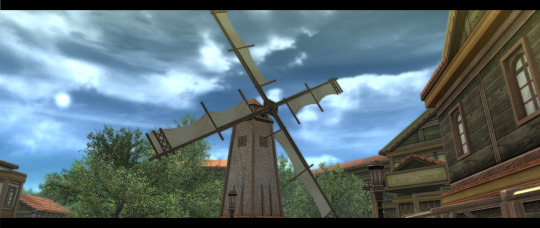
Ultrawide Aspect Ratio Support
I was talking about a surprise feature that I didn’t believe XSEED would go for in my previous post, and this is it. Supporting additional aspect ratios in a game as UI-heavy as a JRPG, and one that was only ever targeted at 16:9, is never trivial, so my time estimate for this included several full work days. Since time is, in a very real sense, money in this case, I didn’t expect that XSEED would go for implementing a feature which – as of the latest Steam survey – is only really useful for less than 2% of the potential players.
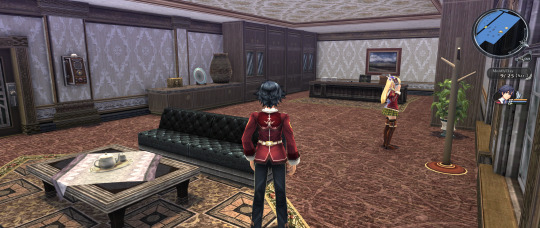
Well, they did go for it, and after working through 32 distinct issues the game now supports any aspect ration larger than 16:9 out of the box! Of course, there are some limitations: primarily, that the main menu remains at 16:9, and also some battle UI overlays don’t transition perfectly at the edges of the 16:9 frame. But for most situations, I implemented unique solutions that I think look pretty nice.

Of course, if I was going to do wide aspect ratio support, I wasn’t going to do it just for 21:9 – every aspect ratio larger than 16:9 should work, at least in theory. So if, say, you have a 3-monitor 48:9 setup, then that will look a bit like this:

I have to admit that, just because of the constraints of reality, the ultrawide option is not tested as rigorously as playing at 16:9, so it’s not unlikely that you might find a small graphical hiccup in one particular scenario in the game or another. If you do, please report it.
Conclusion
Whew. A long road is about to come to its end, and I fervently hope that the game will work as well for you as it does on our testing machines. It’s the first time a game is released where I have been largely responsible for most of its PC-specific code, so I’m a bit nervous, but I do believe that it’s in a much better state than many of the releases I had a look at over the past few years.
And what I know is that if something major does go wrong, I won’t wait months, weeks, or even days to communicate with whoever is affected and try to get it resolved.
Welcome to the second part of this 3-part series on the PC port of Trails of Cold Steel. The first part dealt with lifting the performance of the game to a level that I consider acceptable – great even. Of course, you might now be wondering what to do with all that performance headroom if you’re planning to play on something faster than a GPD Win. After all, there isn’t really any need to run a turn-based JRPG at 300 FPS or more.
In this article I’ll introduce the various graphical settings I’ve added to the game, going into a bit more detail on some of them. I’ve been looking forward to this one in particular, so I hope you enjoy reading it as much as I did writing it.
The Launcher
Let’s start with a look at the game’s launcher:

There are a few things I’d like to remark on:
- Every single option has a description text, and often it also shows visual comparisons of the settings (on the right)
- The entire launcher you see here can be navigated just using a gamepad (actually, I made a tool for this that allows natural 2D-navigation and changing options in arbitrary C# WinForms dialogs using Xinput, and XSEED has graciously agreed to allow me to open source it, so look for that on my blog when things are less hectic)
- Can you spot the typo on this screenshot? It’s fixed by now.
The rest of this article will look at the options contained in the “Display”, “Image Quality”, “Shading” and “Graphics” sections of the launcher in order.
Display
Here, you have the basic choice between windowed or fullscreen rendering with or without v-sync. In terms of framerate, there are 3 settings: a 30 FPS limit, a 60 FPS limit, and unlimited FPS. While the game was 30 FPS on consoles, in the PC version both 30 and 60 are fully supported. Unlimited variable FPS also work very well in all my testing, but are not fully QA’d throughout the game and offered on a “your own risk” basis.
Finally, I’ve also added an option for adjusting the Field of View (FoV). While not as important as in first-person games, playing close to a large monitor often makes a larger Field of View desirable. Here you see a comparison between the default FoV (left) and a very high setting (I wouldn’t personally choose one this high, it’s just for illustration):
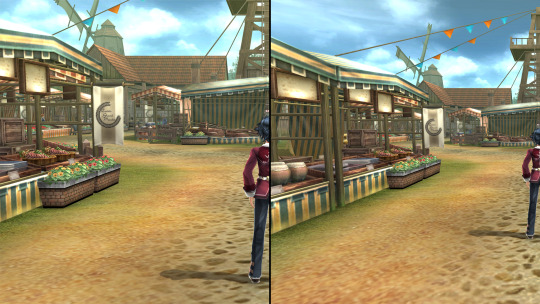
Image Quality
This section deals with resolution, anti-aliasing (AA) and texture filtering. Resolution works as you would expect. In terms of anti-aliasing, MSAA 2x, 4x and 8x are supported, and transparency supersampling (TrSSAA) is there as a high-end option to improve the quality of alpha-tested surfaces. It was strange to discover that TrSSAA is actually significantly more difficult to implement in DX11 than it is in Direct3D 9 or OpenGL, but at least that explains why so few games offer it. Here is a comparison to show what each option does – of course, the difference is much more pronounced in motion:

Before we move on to shading, there’s one thing I need to get off my chest. You know what really annoys me? When games offer some AA option, but do not apply that AA solution consistently to everything in the game (like e.g. character models in menus.) I had to extend the underlying engine to do it, but rest assured that when you select an AA option in Trails of Cold Steel on PC, everything will get that level of AA:
- The main game rendering will be AA’d of course.
- The rendered character dialogue portraits will also get the AA.
- The character models shown on the equip screen? AA’d.
- Character busts during special events? AA’d.
- Yes, even the minimap rendering gets MSAA. And TrSSA. Because why not!
Oh, and there’s an anisotropic filtering option. It’s just a checkbox, because honestly, there’s no reason to bother with less than 16xAF for this game. Even the GPD Win can do it!
Shading
Now this is where things get even more interesting. There are four options related to the quality of dynamic shadows:
- Shadow Resolution, which, as you’d expect, adjusts the resolution of the shadow maps all the way from “low” to “absurd”.

- Shadow Casters, changing which objects cast shadows. Shadows are often enabled only selectively for performance reasons, with artists manually selecting which objects and characters are sufficiently “important” to cast shadows. This setting overrides that selection and makes every object in the scene cast a shadow.
- Shadow Distance, which can increase the distance shadows are cast at. Ever annoyed by shadows appearing and disappearing a few meters in front of you? I know I am. Well, not on my watch.
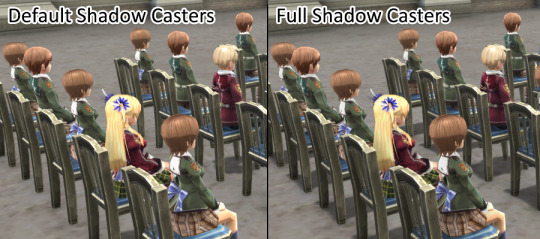
- Finally,Shadow Filtering enables softer and more aesthetically pleasing shadow transitions.
Even with these improved real-time shadows, the game’s environments still looked a bit flat. Since the environments, unlike the characters’ cel shading, are rendered and shaded in a more realistic style, I thought that a more realistic modern technique, namely ambient occlusion, might look good. With some engine improvements I was able to integrateHBAO+, one of the highest-quality and best-performing AO solutions available:
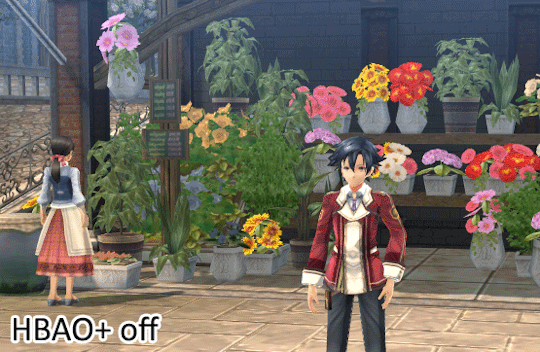
As you can see, it lends everything a lot more depth and plasticity, and also makes objects in the shadows appear more grounded.
Graphics
Last, but certainly not least, the “Graphics” options seem comparatively unexciting with just two checkboxes: and really, the High Quality Depth of Field setting just does what it says on the tin and while it’s a nice improvement, it’s nothing to write home about.
On the other hand, the Unlimited Draw Distance option is, and excuse me if I say so myself, a really big deal. In fact, doing something about the draw distance was one of the very first requests that came up when the first article was posted. What I’ve done about it is completely eliminate any form of pop-in, by making all objects and characters draw at any range. On some maps this is quite a significant extra CPU load, especially combined with full shadow casters, but nothing a modern Desktop PC can’t easily deal with.
Since pop-in is hard to demonstrate in images, I’ve made a video that really shows off the considerable effect of this option.
Other Improvements and Conclusion
In addition to these options, there are a few graphical improvements over the console version that are “always on” and don’t have a launcher option. For example, the glow effects are rendered at 4 times the fidelity, and uncompressed textures are used instead of the compressed assets designed for consoles wherever they were available.
I hope you’ll enjoy these graphical improvements as much as I enjoyed creating them and writing about them. In the final article, we’ll have a look at some non-graphical features, and one particular, somewhat programming-intensive graphical option that will make a few people really happy and which I never expected XSEED to go for. Till then!
When XSEED approached me about contributing to their in-progress The Legend of Heroes: Trails of Cold Steel port, I was immediately excited about the prospect. The Trails in the Sky series features some of my favourite JRPGs on PC, so I looked forward to making this later game in the franchise the best it can be on PC.
Of course, back at that point I didn’t quite anticipate just how involved I would get - I was expecting to do some optimization here and there, maybe amounting to a week or two of full-time work. Reality would turn out different, and in this series of articles I’ll give you some idea of why.
The series is currently planned in 3 parts, leading up to the release of the game on August 2nd:
- Thefirst part, which you are reading right now, deals with performance aspects, primarily framerates and loading times.
- Thesecond part will describe the graphical enhancements and options available in the PC version, and how they came about.
- Finally, the third part will go into some specific features of the PC port that aren’t direct graphical enhancements, and explain some of the challenges in implementing them.
The Beginning of the Performance Story
It seems appropriate for a story about a program to begin with loading, and the initial issue that I was consulted on were in fact loading times. In the PC version of the game at that point, even on a fast machine, loading would routinely take upwards of 20 seconds. And these were not some infrequent large loads, but rather loading which occurred e.g. every single time a battle started and ended. Additionally, significant loading stutters were present frequently throughout the game.
This was of course not an acceptable state of affairs. After a lengthy analysis, I figured out that the primary reason for both the stutters and the loading was that the game’s engine used Nvidia Cg (a - by now - very outdated and unsupported high-level shading language toolkit) to compile and load shaders at runtime. By caching and reusing shader compilation results, I was able to reduce loading times (after the initial load) to ~2-3 seconds, and also eliminate most stutter after a startup phase. Satisfied with the progress on the particular issue I was contacted about, I reported my findings and code.
Standards
Some time later, I was tasked with polishing up the game for its eventual release. While I spent some time improving graphical aspects in the game’s Cg-based version which existed at that point, with more playtesting I grew increasingly dissatisfied with its performance.
As the game was originally released on PS3 and even Vita (though the PC version only uses PS3-level assets and effects or better), you would expect a fast desktop system to churn through it with incredible ease. However, at that point I had already discovered a specific scene and camera perspective in which my PC dropped down to 45 frames per second, completely CPU limited. Using a variety of profiling tools I discovered that the issue was primarily related to how the OpenGL/Cg rendering backend of the engine managed shader state, ending up with dozens of state setting calls for each individual draw call. By doing some of the more obvious optimizations and tweaks, I brought performance in my testing scene up to 55 FPS. At that point, I estimated that by fully optimizing the Cg-based renderer I might get the game up to around 80 FPS on my PC in that scene at best.
That wasn’t going to be good enough.
I could never accept a port with my name on it for a game that ran on PS3 at 30 FPS which only gets up to 80 FPS on my fast 2015 desktop system. In fact, I’d personally like to run a game like this on a low-power portable like the GPD Win, and with that level of performance this wouldn’t be possible.
Changing Horses Midstream
The only true solution to the performance issue would be to completely replace the rendering backend. The underlying engine already had a DX11 backend, but unlike OpenGL/Cg it was clearly not used by Falcom during the development of Trails of Cold Steel, and the game and its assets used a very large array of features not available or not functioning in the same way in in the DX11 backend. As such, switching to the different renderer was actually a larger change in some ways than all of the PC porting work that had been done up to this point.
To give you a better understanding of what this means, here is the first screenshot I took during development of the DX11 version – and note that this was already after fixing a number of issues that would prevent the game from even starting:

In this screenshot you can see over a dozen separate rendering issues, some of which required fundamental engine extensions and reworking to fix. However, they were still just a subset of a final tally of 57 separate classes of rendering problems (not individual instances) related to changing the rendering backend. There’s no way I can go into all of them, but here is a particularly amusing one I was tracking at a much later point during development - as you can tell by everything no longer being a horrible mess:

The Result
Regardless of all these issues and the effort required for porting to an entirely different rendering backend, it was all worth it in the end. The following chart gives you an idea of the (CPU) performance of the game on my PC at various stages in development:

The current state of the game, designated as “Optimized DX11 version”, is more in line with what you would expect from a good PS3 to PC port.
I’d like to note one important fact about this chart: please don’t quote it as some kind of argument for how much faster DX11 is compared to OpenGL - this result is a direct consequence of how these APIs are used in their respective rendering backends in the underlying engine. I assume that the GL/Cg version is designed more as a development aid to very closely resemble the console targets than for performance on PC.
Reaching almost 300 FPS on a high-end PC is nice, but ultimately rather pointless in a turn-based JRPG. What is more interesting and the real fruit of all this effort is performance on a really low-end system, such as the GPD Win portable. This video shows the game running on that device, and as you can see the mission of smooth gameplay on a portable at native 1280x720 resolution was accomplished. In terms of settings, this video uses the game’s “portable” settings, and what exactly that means - and also some ways in which the PC version will allow you to spend the massive performance overhead on a fast desktop PC - will be the topic of my next post about Trails of Cold Steel on PC.
Hi, kids!
This is Brittany, Localization Producer at XSEED, editor/graphic text monkey/what-have-you for Trails in the Sky the 3rd, and current head for the Trails series in general. I’m very eager to write this blog, because it’ll be full of updates for FC,SC, and the 3rd.
Let’s get the 3rd’s status out of the way: schedule-wise, we’re currently doing great! When we announced this game last year, I was dead set on getting it out by spring 2017, so I’m very proud to say that goal is being met. Trails in the Sky the 3rd is coming to PC in English on…a date you’ll find out very, very soon.
Barring typos or odd QA hiccups (which can happen when “smashing” PSP and PC code together to get the best of both worlds), the game is in pretty good shape and we’re right where we need to be. It’s cleaning up very well.

| QA is a sexy time and I won’t let you take it away from me.
I’d like to start by properly warning Trails newbies first: please play Trails in the Sky’s first and second chapters before playing the 3rd. Heck, please play them before even reading this blog! Although the 3rd is not a “third chapter” since the Estelle and Liberl’s story wrapped up with SC, this story still relies on knowledge gained by playing those two games. Internally, I’ve said before that the 3rd has only one target audience: people who’ve played both Trails FCandSC. Cold Steelfanswillunderstand some of the lore dumping, but other details will be quite lost on lost you. Though, hey, if you want to purchase it anyway and help support my coffee fund, I ain’t gonna stop you. (Please buy it and play it later. I’m desperate, here.)
I would have loved for this blog to feature more specific details on the 3rd itself, but I tend to consider the series as a whole whenever I do my editing and am constantly referencing/perusing the text from the other games as if they were my current projects. Because of that, I’m going to be noting planned adjustments for the Sky trilogy that I decided were important enough to implement while I was working on the 3rd. We can dig into protagonist and deuteragonist Kevin Graham and Ries Argent in future blogs.
-Dead Emperor Sword > Sword of Abaddon – Loewe’s S-Craft. I meant to fix this during SC’s QA, but there were so many things I was brushing up till the last minute that it was lost in the shuffle. The original is straight-up wrong.
-Pillar of Salt > Salt Pale – You’ll learn more about this in the 3rd.
-Stainrose > Steinrose – This is a classy alcoholic drink briefly mentioned by Schera in Trails FC. This is clearly meant to be Steinrose and was written correctly in SC, so we’re extending that correction to FC.
-Museum Descriptions – Text in the museum in Grancel will either be rewritten or greatly expanded upon in general. These descriptions were shorter due to every editor’s wariness of character limits in games, but that’s not actually a worry here, so woohoo! The Capel will also receive similar tweaks.
-Master/King/Guardian of the Lake – I don’t understand how I missed this one, but boy, did I screw up when doing sweeps. You might remember the Guardian from Cold Steel; it’s a legendary fish. Well, the whole legendary fish thing actually dates back as far as the first game. Turns out, we’ve used a mix of king or master to describe it. I’d considered using the more common of the two in the current text, “master,” but I realized “master” is used in several other forms throughoutFCandSC. To make its intent clear, I’m going the easy route and replacing all instances of king/King/master/Master with “Guardian” like the way it is in Cold Steel I&II.

| Mysterious boy who isn’t so mysterious if you’ve already played Cold Steel. This marks his first Trailsappearance.
- Duke Dunan – I believe that even if he’s Queen Alicia II’s nephew, being a duke, he should be addressed as “Your Grace.” He’s been addressed as a number of things, including “Your Excellency” by Phillip and Kanone, so this will be corrected.
-Sky Bandits – I talked about this a bit with the current series translator, and we decided that the term ‘sky bandits’ wasn’t the name of the Capua family’s group in particular. They’re simply bandits…who happen to do their bandit-ing while piloting a sweet airship. It’s not a term specific to them, but as generic as “thief” or “schoolteacher.” It shall be decapped in all instances throughout the trilogy.
There are a few more words I decided to decap, and no doubt I’ll find even more in the future. They’re minor in comparison, though, so they’re not really worth listing here.
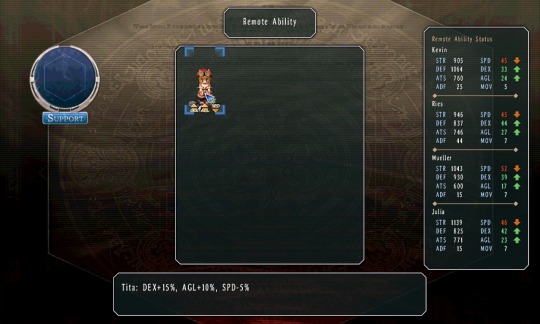
| Here’s a new feature, the “Remote Ability.”
-Airship/Orbalship/Flying Boats – Here’s one that’s bothered me for some time even though I couldn’t figure out a better solution. There’s an entry in the Capel about orbal airships stating that ships less than 20 arge in length are known as “flying boats.” We don’t actually use that term anywhere else, but no one ever brought it up so I left it as is. While reading through the games again, however, I noticed that we used both “airship” and “orbalship” as generic terms.
It’s specifically thanks to orbal energy and the Orbal Revolution that modern civilization in Zemuria was able to achieve flight, so presumably all airships regardless of length use orbal energy. I don’t think it’s a stretch to scientifically classify small ships as “airships,” larger ships which require significant orbal energy as “orbalships,” and have “airships” be used as a generic term among citizens at the same time. After all, we in real life still can’t seem to decide if Pluto is classified as a damn planet or not, even if the population generally seems to refer to it as a planet no matter what its classification is. With this update, I will do away with the clunky and never-used “flying boats” in favor of the current entry.
-Hmm-Hmm!/Hm-Hm!/Etc. – Like Cold Steel I&II, this kind of chortle/laughter isn’t present at all in the 3rd. It was toned down considerably before launch in SC, but it’s still present in both FCandSC. I’ve always wanted to go through the script and alter/remove these, and I finally did! Maybe some will object to this decision, but if they’re not in the newer games, it’s just kinda weird to keep them in the older games, too. In case you wanted to know how much I suffered to do this:
o “hmm-hmm” (164 hits in 96 files)
o “hmmhmm” (184 hits in 85 files)
o “hmhm” (89 hits in 52 files)
o “hm-hm” (8 hits in 8 files)
o “hmm!” (12 hits in 11 files)
o “hm!” (21 hits in 20 files)
o “hmm.” (36 hits in 35 files)
o “hm.” (17 hits in 16 files)
o “Hm,” (62 hits in 41 files)
o “hmm,” (282 hits in 155 files)
-Duke/Baron Fisher – You might recall the president of the Fisherman’s Guild, Mr. Fisher. (Or maybe you do not recall, which suits me better. HEH.) Apparently, his title is mentioned once in both FCandSC—the first time was the “Duke of Angling” and second time was “Baron of Fishing.” This also comes up in the 3rd, but we thought “Fishing Baron” was a simple enough title for the guy, so this will also be fixed in FCandSC.

| From the 3rd’s opening animation.
-Social Sciences/Studies – This is the program Kloe takes at Jenis. I noticed a discrepancy here and there while doing some digging for the name, so all of these have been changed to “social studies.” It’s social sciences in Cold Steel, but since that’s a different country, I don’t consider the difference a big deal.
-Faculty/Staff Office/Lounge – Also noticed this was a number of slightly difference things, so it shall be changed to “faculty lounge.”
-Dorms/Dorm – Unless the person mentioning the dorms at Jenis is referencing both the boys’ and girls’ dorms, I made it singular since there’s only one dorm building each. Not really a problem, but it was bugging me.
-Olivier: “In fact, I believe the Imperial Academy was to launch an investigation…but then the Hundred Days War broke out.” - *nerd glasses* Okay, this one is really cool to me!! I happened to notice the line and was confused by “Imperial Academy, so I checked the Japanese, which was more like “Imperial Science Institute.” Turns out, this is the very same “Imperial Institute of Science” that’s been brought up a few times throughout the Cold Steel arc. (Ahh, I just love how this series connects the little things.)
-Dad/Daddy/Papa/Mom/Mommy/Momma – Estelle as a child calls Cassius “Daddy” in FC, but she says “Papa” in SC.SC will now match FC. Cassius still calls himself “Papa” when babying Estelle, though. I haven’t looked too deeply into this yet, but it’s also been fixed in the following instances so far:
o Anya - Daddy(FC), Papa/Daddy(SC) = Daddy
o Elke - Papa(FC), Papa/Dad(SC) = Dad
o Mirano - Father(FC), Papa/Father(SC) = Father
o Louis - Dad/Mom(FC), Papa/Mama & Dad/Mom (SC) = Dad/Mom
o Helena - Dad/Mom (FC), Papa/Mama (SC) = Dad/Mom
o Lucia - Mommy (FC), Mom/Mommy(SC) = Mommy
I feel ashamed to see all of this…
-Mayor/Lady/Miss/Ms. Maybelle – This one was pretty wild. When checking her address for the 3rd since Lila’s address was translated as “Lady Maybelle,” I went through FC/SC and the results were a mess. Some NPCs referred to her in three different ways, and Estelle went from “Mayor Maybelle” in FC to “Maybelle” in SC. One could argue closeness allowed her to drop the formalities, but I don’t see them as that close. Virtually everyone should be calling her “Mayor Maybelle” now, save for four exceptions: Lila, who calls her “Miss Maybelle, ” and Kloe, General Morgan, and Yahat, who affectionally call her “Maybelle.”
This biggest change affecting all these Sky games, however, will be this:

| You don’t know how happy it makes me to see this.
To refresh your memories, Zin Vathek is an A-rank bracer from the Calvard Republic, and he’s one of the main playable characters throughout the trilogy. However, due to some absurd reason I can’t even begin to understand since I wasn’t with XSEED at the time, the original translation team insisted upon changing his name to Zane.
The series has yet to truly set foot on Calvardian soil, but several characters from there appear to be of Eastern descent. This may lead some to believe that Calvard is mostly an “Asian” country, but personally, I think something very different is going on. Republican names also include stuff like Vathek, Cochrane, or Rocksmith (the Republic’s president). There’s even the Gambler Jack novel that stars a white man named…Jack…and includes characters like Chief Minister Shamrock and Enrique.
I believe Easterners are actually the minority in Calvard, and Eastern influences are reflected in a Chinatown-esque area called the “Eastern Quarter.” Even the writing in Gambler Jack mentions how immigrants tend to gather in the Eastern Quarter, and the writing goes out of its way to point out Eastern features in Halle, the heroine, as if it’s not usual for its author to see.
Throughout the localized games, there have been mentions of people from farther east immigrating into Calvard to the point where it’s become a problem. Incredibly interesting as this is, it’s only been brought up in bits and pieces throughout the series, so I can only make an educated guess on what exactly Calvard is like or what’s going on within. Also, you’ll learn more about this in 3rd and I don’t want to go into detail. These kinds of things could point to racial tension in the future or something else entirely. The more I’ve learned, the more my gut tells me that there’s a reason for these characters—Zin included—to have been given Eastern-influenced names.
While I’ve never been fond of “Zane” to begin with and believe it never should have been changed in the first place, I do understand that it’s been a part of the Trails English canon for many years. Before making the change, I tried to think of various solutions and consulted Falcom’s development team directly with my thoughts. One possible solution was based on many friends who immigrated to the West as children: they had their name from birth, and then they also had a more “white-sounding” name to further blend into Western culture. I thought this method would allow us to keep Zane, finally adopt Zin, and give Zane a few unexpected extra layers.
I’m happy that I expressed these concerns to Falcom’s team, because it gave me the confidence to do away with the more complex solutions and just skip to the overhaul. Moving forward, “Zane” will officially be “Zin” for the entire Trails in the Sky trilogy, and “Zane” will be a thing of the past. I’m excited about this. Please welcome Zin warmly.
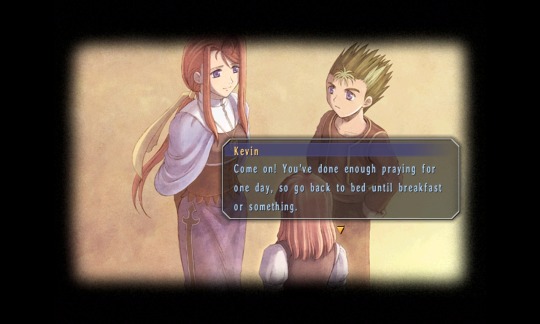
| You’ll see cutscenes like these throughout the game.
In the Future/Other Notes
-Gambler Jack – This novel appears in both Trails in the Sky SCandTrails of Cold Steel II. The CS2 version was brushed up. This may or may not make it into this next update, but I’d like to backport this when I can.
-Skippable S-Crafts – We added this patch into the PC versions of FC/SC in December 2016, but I felt it was worth noting since it’s not in any other version of the Sky trilogy but ours. You can now skip S-Crafts with the press of a button! Yay!
-S-Craft Voices – Years and years ago, before my time, the Trails in the Sky trilogy was all dubbed at once just because it was battle lines and it was easier to get it all finished in one go. Some mistranslations happened here and there in those battle lines. It’s why Kloe shouts, “Radiant Plash!” instead of her actual S-Craft name, for example. The lines from one of Kevin’s S-Crafts gets mentioned as part of 3rd’s story, and you might notice it differs from the text in his actual S-Craft. I’d like to fix the voice someday, but we’ll have to work with the original for now. Just know that it was a conscious decision to not match the story text and battle lines.
-NPC Names – Like Zin, a few NPC names I believe have references that were initially missed. Mirano/Trino/Modena are supposed to be Milan/Turin/Modena, I believe, Stain is supposed to be Stein, etc. These all these like relatively minor in the grand scheme of things and have no real impact on the world-building, though, so I’m still compiling a list and debating if it’s even worth touching this. I still want to…but lol.
NPCs are truly trouble in this series… I have a bible I made myself for the series, but I’d love to keep filling it in!!
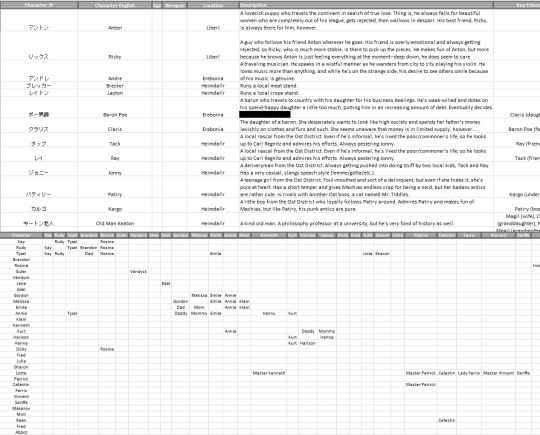
|I’m slowly building stuff like this in the name of obsession.
Ideally, one of the other big changes would be the basic name on Steam/GOG/Humble being displayed. We’ve always gone with Trails in the SkyandTrails in the Sky SC, but I worry names like these as an introductory header may cause confusion among newer fans. I want to someday rename these display names Trails in the Sky First ChapterandTrails in the Sky Second Chapter. We’ll see.
My hope is that outside of Zane > Zin, you guys noticed approximately none of these things and will end up reading this blog and going, “Huh. This person’s obsessed, but okay. Cool.” But how do these things happen? The same way it always happens with text-heavy games: too many cooks in the kitchen. Too many translators, too many editors. Many of these choices are perfectly valid out of world context, but when you’re given thousands of files, no unified index for characters unless you build it from scratch yourself, and some very nasty deadlines, things happen.
The series is much more unified than ever because we realized that when it comes to text-heavy projects, taking our time with a smaller team yields a much better result than throwing as many people as possible at it. CS1,CS2, and the 3rd proved it. In a perfect world, I could go over FCandSC’s text line by line and tweak things in ways fans likely wouldn’t notice just to create further consistency, but considering I do these tweaks in my free time out of pure passion for the series, that’s gonna have to be saved for another day. I’m already very blessed to be given the opportunity to comb through older files and tweak at my leisure. Or maybe I just have a very unusual hobby.
Should you come across any issues that have cropped up unexpectedly with this update (which will be before the 3rd’s launch), please feel free to contact us. Stuff happens, things break, but we’re always willing to look into it and fix it if it’s within our power. My heart belongs to the series forever, so anything I can do if time allows it, I try. Thanks for reading this update, kids, and I hope to write more about the 3rd soon!

| Yes, this actually is in the game.
It has now been a bit more than half a year since Trails of Cold Steel was launched on PC. That was the first game for which I contributed the majority of the porting effort, and it made me believe that I could also take on a complete end-to-end porting project for its sequel. That sequel - Trails of Cold Steel II - was released yesterday, and in this blog post I’ll talk a bit about all the features it implements beyond what was seen in the previous releases.
Read More: https://goo.gl/njM9gM

Commission for hellabooneof Rean and Sara!
Please don’t repost
A Trails of Cold Steel + Granblue Fantasy crossover commission! May there one day be a real event with these two game series’ together, kicking butt with weapons and every colour of magic.
Zoomies and Sketches on my Instagram: https://www.instagram.com/p/CNsbJR4DbRl/?utm_source=ig_web_copy_link
Post link


